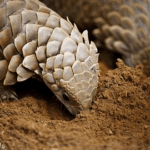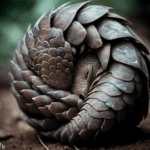How Do Pangolins Protect Themselves? Pangolins have armor-like scales that help them protect themselves. Curling up into a tight ball with overlapping scales acts like a shield. As if that wasn’t enough, they can also emit a strong, pungent odor from their glands near their anus! Plus, they are great swimmers and climbers.
Sadly, they are critically endangered due to poaching and illegal hunting for their meat and scales. We need to take action to save these incredible creatures!
Key Takeaways
- Pangolins have a unique defense mechanism that involves rolling up into a tight ball to protect themselves from predators.
- Their scales, made of keratin, act as a shield against potential threats.
- Pangolins also have sharp claws that they use for digging into the ground or climbing trees, which helps them escape from danger.-
- When threatened, pangolins can emit a foul-smelling odor or make hissing sounds to deter predators.
- Despite their impressive defense mechanisms, pangolins are still highly vulnerable to poaching and habitat loss, making them one of the most endangered species in the world.
Background Information on Pangolins
Pangolins are so intriguing! They have scales, which make them stand out from other animals. Let’s explore the facts about them quickly.
Check out this table to get a better understanding:
| Attributes | Features |
|---|---|
| Appearance | Covered in scales |
| Diet | Mainly ants and termites |
| Habitat | Forests and grasslands |
Their traits are truly remarkable! They have long tongues that help them slurp up their favorite food – ants, and termites. Their claws help them break open insect nests. They live in forests and grasslands and have adapted to their environment.
Fun fact – the scientific name for pangolins is Pholidota! They are the only mammals with scales covering their bodies, which provides them with great protection.
So, there’s no need for a suit of armor when you’re a pangolin. They’ve perfected the art of self-defense! (Source: World Wildlife Fund for Nature)
Physical Adaptations for Self-Defense
To better understand the physical adaptations pangolins employ for self-defense, delve into the section “Physical Adaptations for Self-Defense” with a focus on the sub-sections “Scales” and “Curling into a Ball.” Discover how these mechanisms serve as effective solutions for ensuring their protection in the face of threats.
Scales

Scales come in many shapes, sizes, and forms for different species. Here’s a glimpse of some animals and their unique scales:
| Animal | Scale |
|---|---|
| Pangolin | Overlapping Keratin Scales |
| Armadillo | Bony Plates |
| Fish | Placoid Scales |
| Snake | Epidermal Scales |
Pangolins have overlapping keratin scales as a form of natural armor. Armadillos use bony plates for protection. Fish have placoid scales to help them swim better and defend themselves. Snakes have epidermal scales to help them move and protect themselves.
Scales offer other benefits too. Fish scales help keep their body temperature steady.
It’s amazing to see how animals use these external coverings to defend themselves. The different kinds of scales show the adaptability and survival strategies of the animal kingdom.
The Smithsonian’s National Zoo & Conservation Biology Institute say that when pangolins are threatened, they curl up in a ball and use their scales to protect themselves. Who knew self-defense could be done with a human burrito?
Curling into a Ball
Animals across various species employ curling into a ball as a physical defense mechanism. Its simplicity, efficiency, and instinctual nature make it an advantageous strategy for protection. This is highlighted by the armadillo’s historical use of this adaptation, showing its effectiveness in ensuring survival. With karate chops to running away, these behavioral adaptations guarantee protection – unless it’s for a good laugh!
Behavioral Adaptations for Self-Defense
To develop the best self-defense strategies for pangolins, we will closely examine their behavioral adaptations. By focusing on camouflaging and emitting noxious smells, we can uncover effective solutions that complement their natural defense mechanisms.
Emitting Noxious Smell
Emitting a noxious smell is an adaptation seen in some creatures to defend themselves. When threatened, they release a strong, unpleasant odor as a deterrent. This is common in skunks and some insects.
The odor also serves another purpose; it warns others of potential danger. This way, it not only protects the one releasing it, but the whole group.
Organisms have special glands or structures within their bodies that produce and store chemicals responsible for the smell. These compounds differ from species to species. Some emit sulfurous gases, while others release pungent organic compounds.
If humans could emit such odors, exploring non-lethal alternatives would be beneficial. We could create personal safety devices that release bad smells when activated. Or, we could incorporate odor-releasing substances into everyday objects or clothing, so they release an offensive smell when tampered with.
We must consider the effects these odors may have on those around us. The purpose should be to repel aggression without causing harm or discomfort. Research should be done to ensure the substances are safe. And of course, the best defense against predators is having kids who can fight for you!
Reproduction and Parental Care
To better understand how pangolins protect themselves in terms of reproduction and parental care, delve into the role of mothers in safeguarding their offspring. Explore the unique methods these incredible creatures employ to ensure the survival and well-being of their young.
Role of Mothers in Protecting Offspring

Mothers in the animal kingdom are vital for protecting their young. Different species have adapted unique strategies for safety. For example, creating nests, burrows, or dens provides protection from predators and harsh conditions. Mothers also actively defend their offspring with aggression, vocalizations, or physical presence. In some cases, they even sacrifice themselves.
Nourishment is another key role of mothers. Mammals produce milk for their babies, while birds regurgitate food or teach them to hunt. Social interactions also help offspring learn skills, such as hunting techniques and communication signals.
The role of mothers is quite varied. Elephants form strong bonds within herds, with the matriarch leading and protecting both her own calves and others.
Maternal care is key for the survival of future generations. Their instincts, behaviors, and adaptations ensure the success of each species in maintaining population levels.
Conservation Efforts for Pangolins
To ensure the survival of pangolins, conservation efforts are crucial. In order to address the challenges faced by these unique creatures, this section focuses on the importance of combating illegal trade and poaching. Additionally, it highlights various conservation organizations and initiatives dedicated to protecting pangolins.
Illegal Trade and Poaching
Pangolins are highly sought-after in the illegal wildlife trade for their medicinal scales and meat considered a delicacy. This causes extensive poaching with no penalties, leading to horrendous deaths. The decline of pangolin populations is mainly due to illegal trade and poaching.
To protect themselves, they roll into a tight ball when threatened. But this hasn’t been enough to save them from humans. Support organizations that fight illegal wildlife trade and spread awareness about pangolin conservation. Your contribution can make a huge difference for these endangered animals! Conservation organizations are working hard to save pangolins – proving that superheroes can come in scaly armor, too.
Conservation Organizations and Initiatives
Conservation organizations and initiatives are really important for saving pangolins. Here are five key points about them:

- World Wildlife Fund (WWF): A big global group, focusing on guarding endangered species, like pangolins. Protecting their habitats and helping with sustainable practices.
- Pangolin Conservation: This initiative wants to spread understanding about the troubles pangolins face. They team up with local communities, governments, and scientists to achieve their aim.
- International Union for Conservation of Nature (IUCN): This org inspects the conservation status of species worldwide. They offer guidelines, based on scientific research and data, for pangolin conservation efforts.
- Save Vietnam’s Wildlife: In Vietnam, they work to rescue injured pangolins from the illegal wildlife trade. And then rehabilitating and releasing them into protected areas.
- African Pangolin Working Group (APWG): Focusing on African pangolin species, this group does research, trains, and engages in community outreach programs to reduce poaching and trafficking.
Plus, there are initiatives for raising public awareness through educational campaigns. They are trying to change attitudes towards pangolins and reduce demand for their products.
Here’s an inspiring story. In 2019, Bangkok, Thailand, halted a smuggling operation. More than 900 live pangolins were recovered from a truck heading to China. Clearly, robust conservation measures are still needed.
Frequently Asked Questions
1. How do pangolins protect themselves?
Pangolins protect themselves in a few different ways. One of their main defense mechanisms is their scales, which are made of keratin and act as armor. When threatened, pangolins curl up into a tight ball, covering their vulnerable parts with their scales. They can also use their sharp claws and strong tails to defend themselves or emit a noxious smell to deter predators.
2. Are pangolins good climbers?
Yes, pangolins are excellent climbers. Their strong claws and long tails help them to easily climb trees and scale steep surfaces. They often use their climbing abilities to find food, escape from predators, or reach a safe sleeping spot up in the trees.
3. Do pangolins have any natural enemies?
Pangolins have a few natural enemies, including large predators such as lions, tigers, and leopards. However, their main threat comes from humans, who hunt them for their scales, and meat, or use them in traditional medicine.
4. Can pangolins swim?
While pangolins are not natural swimmers, they are capable of swimming if necessary. They can use their strong tails for propulsion and their claws for paddling. However, they prefer to avoid water whenever possible and are more comfortable on land or in trees.
5. How do baby pangolins protect themselves?
When baby pangolins are born, they are already covered in soft scales. They stay close to their mothers for protection and often ride on their tails or backs. If a threat arises, the mother will curl up around the baby, shielding it with her body and scales.
6. Why are pangolins endangered?
Pangolins are highly endangered due to illegal poaching and trafficking. Their scales are in high demand in some Asian countries for their supposed medicinal properties, and they are also hunted for their meat. This relentless hunting, along with habitat loss, has led to a rapid decline in pangolin populations worldwide.
Conclusion
Pangolins are mysterious creatures with their unique appearance and scaly bodies. They have various defenses against threats. For example, their sharp claws and their ability to curl up into a ball.
Moreover, they have an impressive sense of smell that warns them of danger.
On top of that, pangolins have secretions from their anal glands. When they feel threatened, they produce a foul-smelling substance that deters predators.
Sadly, they are the most illegally trafficked mammals in the world.
We must take action to protect them and ensure their survival for future generations.




